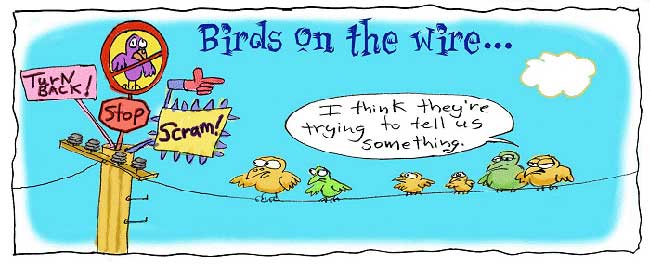在乡间,或是大城市中比较清静的地方,常会看到电线上站着一排一排的鸟儿。看到它们在上面休憩、放松的样子,不知你有没有想过:这些鸟儿为什么不会被电到呢?难到因为它们的爪子绝缘么?下面这篇文章将为您解答这个问题。

High above the ground, electrical and telephone poles and their connecting
wires must seem made for birds, like artificial trees with limbs that stretch on
forever. Sometimes a hundred birds will be stretched out along a wire, in a kind
of high-tension convention.
How come a bird on a wire doesn't get shocked? When the bird perches on a
live wire, her body becomes charged--for the moment, it's at the same voltage as
the wire. But no current flows into her body. A body is a poor conductor
compared to copper wire, so there's no reason for electrons to take a detour
through the bird. More importantly, electrons current flow from a region of high
voltage to one of low voltage. The drifting current, in effect, ignores the
bird.
But if a bird (or a power line worker) accidentally touches an electrical
"ground" while in contact with the high-voltage wire, she completes an
electrical circuit. A ground is a region of approximately zero voltage. The
earth, and anything touching it that can conduct current, is the ground.
Like water flowing over a dam into a river, current surges through the bird
(or person's) body on its way into the ground. Severe injury or death by
electrocution is the result.
That's why a squirrel can run across an electrical line, but sadly die when
its foot makes contact with the (grounded) transformer on the pole at wire's
end.
It's also why drivers and passengers are warned to stay inside the car if it
runs into a downed power line. Touching the ground with your foot would complete
the circuit: Electrons would flow from the wire, into the car, and through you
on their way into the earth. (Inside the car you are usually protected by the
car's four rubber tires, which act as insulators between car and ground.)
Likewise, birds can get in trouble with power lines if wing or wrist
bones--or wet feathers--connect bare wires and grounds.
Raptors (birds of prey) are especially likely to be killed by power lines,
particularly in the western U.S. In wide-open plains and deserts, power poles
are often the only high perches available for hunters like Bald and Golden
eagles and Great Horned owls, who survey the landscape for prey and take off
into rising wind currents.
Such large birds can easily contact two wires or a wire and a transformer
with their great wingspread. And raptors can easily brush against a live wire
while settling onto a (grounded) pole-top. Thousands are killed by power lines
each year.
How to protect big birds? Power lines can be made less dangerous by widening
the gap between conducting and ground wires, insulating wires and metal parts,
and moving wires farther away from pole tops. And guards can be built around
favorite raptor perches.
(来源:how-come.net 英语点津 Annabel 编辑)